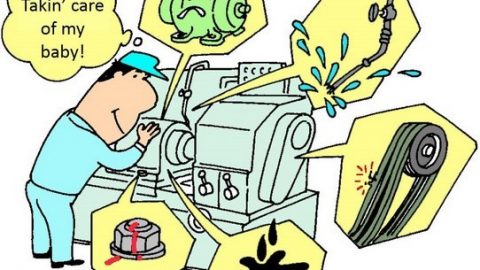While we’ve covered some of the most significant types of risk facing manufacturers, from cybersecurity to economic slumps, another type of risk that warrants discussion is equipment maintenance.
With downtime, profitability and quality on the line, failure to properly maintain and keep up with equipment can quickly lead to major – and expensive – issues for manufacturers. With this in mind, the goal to achieve autonomous maintenance is growing among manufacturers as they strive to reduce risk associated with downtime or broken machinery, while also improving productivity and extending the lifetimes of equipment.
Autonomous maintenance, or operator preventive maintenance, is focused on developing operators’ skills to routinely maintain equipment and identify any potential issues or problems. This gives operators ownership of their equipment, making them responsible for ongoing maintenance such as cleaning, lubricating and inspection.
Simply put, achieving autonomous maintenance requires operators to be trained on potential failure modes and signs that equipment is about to fail. With the right education and training, operators will be empowered to consistently keep their equipment well-cleaned and functioning, which will in turn reduce downtime and improve operational productivity.
To ensure your path to autonomous maintenance is a success, follow these steps to improve your maintenance practices:
- Track failure and breakdown data. This data will form the basis of your maintenance practices and guide operators on which equipment needs the most attention. This involves gathering data and conducting root cause analyses to discover failure modes for different machinery. Charting this data over time will provide an extra layer of analysis as well.
- Establish metrics. To monitor the overall effectiveness of your repairs and equipment, a number of metrics should be tracked and measured. These should include things like Mean Time Between Failures and Mean Time to Repair. By analyzing the patterns present in this data, you can learn to predict and eventually prevent breakdowns, minimizing the time needed for repairs and time taken away from production.
- Identify and document all components that wear out or are known to regularly fail. Utilize non-human sensing devices like oil analysis, thermography, ultrasound or vibration analysis to gain additional insights into equipment failures.
- Create a standard process for generating Work Orders. This should be based on the Planned Maintenance Schedule (as explained below). Additionally, create a maintenance log sheet for each piece of equipment and record every instance of failure or replacement, along with information about the component condition at the time of replacement. Utilizing computerized maintenance management solution (CMMS) software can assist with this.
- Identify all pieces of equipment that are candidates for Autonomous and Planned Preventive Maintenance. Planned maintenance allows your team to schedule maintenance to be conducted during times when the equipment is not scheduled for production. This significantly reduces unplanned production downtime.
- Use Predictive Maintenance for condition-based upkeep. To start, establish a baseline for failure-prone components and a baseline (predicted) failure interval. Then, create a time-based planned maintenance schedule that proactively schedules replacement of all wear and failure-prone components. For this type of schedule, use the duty cycle or “Run Time” as the time base, rather than “Calendar Time.”
Sustain and continue your maintenance practices. On a monthly basis, audit your Planned Maintenance Schedule. Is it consistently being followed? Verify that the Maintenance Log sheets are being maintained as well, and review any new entries. Scheduled maintenance will have to be adjusted when necessary – for example, when unscheduled components fail and must be replaced. Throughout this auditing process, keep things positive and motivational in order to encourage workers to sustain their maintenance efforts.
All manufacturers have daily, monthly and yearly goals that drive their operations each day; goals that cannot be reached without functional equipment. To keep your deliveries on schedule, keep repair costs down and keep equipment running for years to come, put your operators on a path toward autonomous maintenance.
Source: Michigan Manufacturing Center
